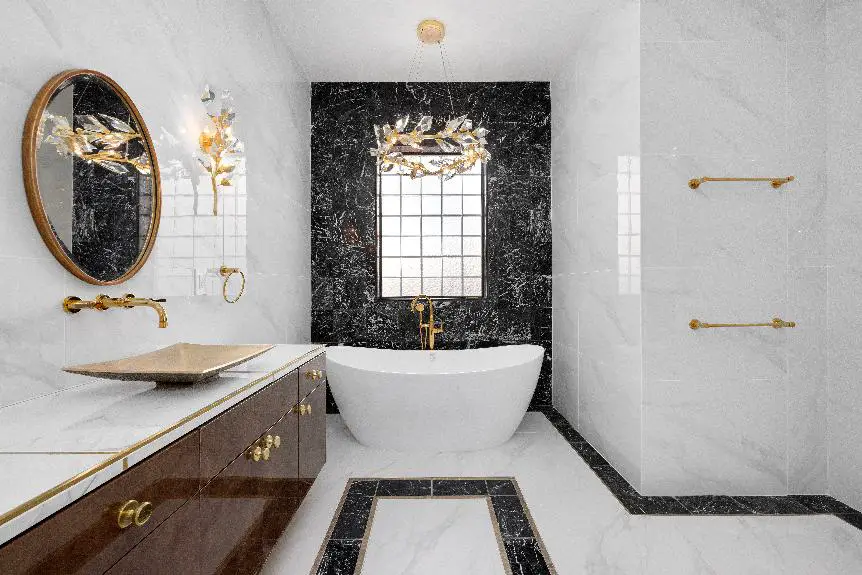Reglazing a bathtub involves several steps:
- Cleaning the tub
- Removing old caulk and fixtures
- Sanding the surface
- Repairing any damage for a smooth base
- Applying a primer (optional)
- Applying the reglazing compound, following the manufacturer's instructions for even application
- Allowing the reglazing material to cure for the recommended time
- Sealing the tub and reinstalling fixtures
These steps result in a refreshed bathtub.
Preparing the Work Area
Before starting the reglazing, protect surrounding areas with drop cloths or plastic sheeting. This is essential to prevent damage to bathroom fixtures and flooring from any unintended splashes or debris.
Begin by thoroughly cleaning the bathtub with a professional-grade cleaner and an abrasive pad, focusing on removing soap scum, mildew, and hard water deposits that could affect the new finish's adhesion. Next, remove the caulk around the bathtub using a caulk removal tool or utility knife, and wipe down the area to clear away any remaining particles.
Continue by taping off the area around the bathtub with high-quality painter's tape to ensure a neat boundary and prevent reglazing materials from spreading to unwanted areas.
Sand the tub lightly with wet/dry sandpaper to remove the old finish's gloss and create a texture that will help the new coating adhere. Follow the sanding with another cleaning to remove any dust.
The tub is now ready for reglazing.
Removing Old Caulk
To remove old caulk, a wallpaper scraper can be used effectively, especially around the tub. This is important for ensuring a good bond during bathtub refinishing. Start by cutting the caulk with the scraper and peeling it off. Take care not to damage the tub's enamel.
After most of the caulk is gone, check for leftovers and use a razor blade if needed. Do not use abrasive cleaners or steel wool as they can scratch the surface, requiring additional repairs.
Once all caulk is removed, clean the bathtub thoroughly to prepare for reglazing. For those using DIY kits, a clean surface is crucial to prevent water damage and mold. Also, remove old caulk from the overflow plate area to avoid leaks.
Cleaning and Sanding
After removing old caulk from a bathtub, the surface must be cleaned and sanded thoroughly before reglazing. This preparation is important for the new finish to adhere properly and be durable.
Start by cleaning with a bleach solution to remove any mildew. Then use an abrasive cleaner or etching powder to create a rougher surface for better bonding with the new epoxy finish.
Once cleaning is finished, rinse the bathtub well to eliminate all cleaning and etching residues. Before proceeding, the tub must be completely dry as moisture can hinder the adhesion of the new finish. Dry the surface with a lint-free towel or a tack cloth to remove dust or debris.
Proceed with sanding the entire tub using wet/dry sandpaper to smooth the surface and enhance the grip of the new finish. After sanding, use a tack cloth to remove any residual dust.
Ensure the tub is clean and dry before applying primer and epoxy coating. Avoid rushing the drying process as it is critical for a successful refinish. A clean, sanded, and dry tub is now ready for reglazing.
Applying the Primer
Applying a high-quality primer is an essential step in bathtub reglazing, necessary for proper finish adhesion. After cleaning and sanding the tub, it is crucial to select an appropriate primer. Professional refinishing often involves epoxy resin-based primers due to their strong adhesion and durability. For DIY kits, use the provided primer designed to work with the kit's materials.
Use a small foam roller and brush to apply the primer evenly, starting with the corners and edges, and then the larger areas. This helps prevent brush marks and bubbles. Apply two coats for complete coverage, allowing each coat to dry for a few hours as per the manufacturer's instructions.
The final coat of primer should cure overnight before proceeding. Proper drying and curing of the primer are vital for the durability of the bathtub's new finish.
Finishing With Reglaze
To apply a final glaze on a reglazed bathtub and achieve a smooth, durable finish, one must follow a process that includes preparation and the use of high-quality refinishing products. The process starts with cleaning, repairing, and priming the bathtub surface before applying the new glaze.
To apply the glaze, mix the epoxy from a Tile Refinishing Kit and pour it into a paint tray. Use a small foam roller suited for smooth surfaces to apply thin, even coats to the main area of the tub, avoiding drips and streaks. For the edges and tight spaces, use a foam brush to ensure even coverage.
While applying the glaze, it's important to maintain a wet edge, blending each section with the next before it dries to avoid lines and imperfections. Patience is important to achieve a finish that adheres properly and is free from brush or roller marks.
Once the glaze is applied, let it cure for the time specified in the product instructions, typically 48 to 72 hours, before using the bathtub. This curing period is essential to ensure that the finish hardens into a durable surface, prolonging the bathtub's lifespan with appropriate maintenance.





